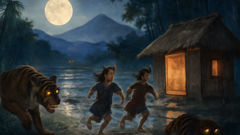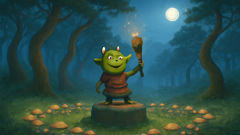Introduction
In the sunbaked heart of the Australian outback lies the legendary Speewah, a stretch of land so vast and wild that it’s said even the horizon gets tired trying to keep up. It’s a place where the dirt is red as rust, the gum trees lean at impossible angles, and the sheep outnumber the people by a margin only a bushman could count. Here, stories aren’t just told—they’re born, battered by dust storms, and grown big enough to make even the toughest drover raise an eyebrow. And in all the tales spun around the billy by the campfire, none loom larger than those of Crooked Mick—the shearer who could split a hair with his shears, out-race a stampede, and wrestle cyclones for a spot of shade on a summer’s day. There’s no map that marks the Speewah, but ask any old-timer at a remote outback pub, and they’ll nod towards the horizon and tell you about the land where the sheep’s wool grows twice as thick, the crows fly backwards to keep the dust out of their eyes, and Crooked Mick left his footprint—so deep that a river sprang up to fill it. With a jaw set like iron and a grin as wide as the Nullarbor Plain, Mick’s name is stitched into the fabric of the bush, a legend passed from father to son, mate to mate, and anyone game enough to listen. Whether he’s wrangling monstrous sheep, besting impossible odds, or tricking the very elements themselves, Crooked Mick’s adventures are the stuff of pure outback gold—a wild blend of humor, grit, and the kind of impossible magic that only grows in the red heart of Australia.
The Birth of a Legend: Crooked Mick’s Early Years on the Speewah
Long before Crooked Mick’s name echoed from the Flinders Ranges to the Gulf Country, the Speewah was a land waiting for a legend. The bush was hard, and life was harder, but it had a strange way of breeding characters as tough as ironbark and as unpredictable as a summer storm. Mick wasn’t born like most folk—some say he arrived in a dust devil that spun off the Nullarbor one morning, landing with such a thump that the kangaroos scattered for miles. Others reckon he was carved from a single slab of ironwood by his mother, a woman who could out-wrestle a goanna and bake a damper that doubled as a wagon wheel. What’s certain is that from the moment he opened his eyes—one blue, one green, and both twinkling with mischief—Mick was as much a part of the Speewah as the red dust itself.
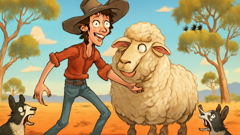
Even as a nipper, Crooked Mick stood out. He was taller than a stockman’s hopes in a drought, with arms like windmill blades and legs that seemed to go on forever. His grin was famously crooked—thanks to a run-in with a cranky magpie chick he tried to rescue from a flooded billabong. That lopsided smile became his trademark, earning him the name Crooked Mick long before he ever picked up a pair of shears. As he grew, so did his legend. He could outrun a brumby across cracked claypans, swim upstream through flooded creeks, and wrestle wild pigs out of waterholes without breaking a sweat. The old bush hands would shake their heads and reckon Mick could muster the clouds if he put his mind to it.
But it wasn’t just his strength that set him apart. Young Mick had a way with animals and people alike. He could calm a spooked colt with a whistle, charm a stubborn sheepdog with a wink, and talk even the most grizzled bushman into lending a hand at mustering time. He learned the language of the land—when to trust the sky, how to find water where none seemed to exist, and what stories could do to turn a hard day soft. By the time he was old enough to swing an axe, Mick was already famous for felling trees in a single blow and splitting logs by staring at them hard enough. His mother, proud and exasperated in equal measure, would sigh and say, “That boy’ll shear the clouds if you let him.”
The Speewah itself shaped him. The land demanded resourcefulness, stubbornness, and a sense of humor sharper than a snake’s fang. Droughts came and went; so did floods that turned dust into chocolate mud and left fish flapping on the front verandah. Through it all, Mick grew into a man who could turn disaster into opportunity. When a dust storm swallowed half the homestead, he built a new one out of spinifex and fence wire. When wildfires threatened, he dug a trench so wide it became the Speewah Creek—so the story goes. Even the crows watched with wary respect whenever Mick strode out across the plains.
By the time he turned sixteen, Crooked Mick was already taller than most grown men and twice as strong. His first job as a shearer came about by accident: the shearing gang was short-handed after a mob of sheep stampeded through the cook’s kitchen, and Mick volunteered to help. Legend has it he picked up the blades, sized up the first sheep—a brute with horns like a bull and a temper to match—and sheared it clean in a single swipe. The fleece came off in one piece, rolled itself into a perfect bundle, and the sheep walked away, proud as punch. The shed fell silent until the old boss called out, “Welcome to the crew, Mick. Hope you brought your own grindstone.”
From that day on, Crooked Mick was the man to beat in every shed from Bourke to Birdsville. His legend grew with every shear—tales of sheep shorn so clean they glowed in the moonlight, of flocks herded across rivers on his back, of droughts ended with a stomp of his boot. But behind the yarns and laughter, Mick remained true to his roots: a man of the land, with a crooked grin and a heart as big as the Speewah itself.
Mick’s Mighty Feats: Shearing, Outback Wonders, and the Shearers’ Strike
Crooked Mick’s fame as the greatest shearer in the outback was forged in the wild clang and clatter of the Speewah’s legendary shearing sheds. These weren’t ordinary sheds—they were as long as a railway siding, built to hold every sheep from here to Alice Springs. Some said the wool was so thick you could lose a horse in it, and the sheep so big they cast shade for a whole mob. In this world, only the toughest hands survived, and Crooked Mick was in a league of his own.
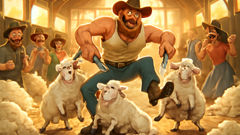
Every year, when shearing season rolled around and the sky shimmered with heat, Mick would stride into the shed, shears slung over his shoulder like a bushman’s swag. The other shearers would watch in awe as he set up his stand, always closest to the big swinging doors so he could greet the day head-on. The click-clack of his blades echoed across the shed, punctuated by bursts of laughter and the occasional yelp as a sheep tried to outwit him. But Mick was quicker than a goanna on hot tin—his hands a blur, his feet never missing a beat. He could shear a hundred sheep before smoko and still have time to help the cook fix the oven or mend a broken fence.
One year, the Speewah faced its worst drought in living memory. The creeks dried up, dust storms rolled in like angry gods, and the sheep grew restless. The station boss declared the shearing must go on, drought or no drought. Mick took it as a challenge. He dug a well so deep he struck an underground river, then redirected it with nothing but a bent spade and a length of fence wire. Water bubbled up across the paddocks, and the sheep—once scraggly and thirsty—grew so fat their wool nearly touched the ground. When the other shearers complained it was impossible to shear such enormous sheep, Mick grinned and rolled up his sleeves. He sheared three at once, tying their wool into a rope so long it reached all the way to the next station.
But it wasn’t just the shearing that built Mick’s legend. He was called on whenever disaster struck. When wildfires threatened to turn the Speewah into a sea of smoke, Mick leapt into action. He dug a firebreak with his bare hands, scooping out earth faster than any team of horses could manage. When a wallaby mob stampeded through the kitchen, Mick rounded them up and sent them hopping back to the bush with a gentle nudge. He built fences that stretched further than most people could walk in a day, and once patched a hole in the water tank using nothing but a handful of gum leaves and his trusty pocketknife.
The most famous tale came during the great Shearers’ Strike. Tensions ran high across the bush—wages were down, tempers flared, and talk of rebellion filled the air. The station boss tried to break the strike by bringing in outsiders, but Mick stood firm with his mates. “A fair go or no go,” he declared, his voice carrying over the paddocks like thunder. The boss, desperate to settle things, challenged Mick to a contest: if Mick could shear more sheep than all the new hands put together in a single day, he’d double everyone’s pay.
The shed was packed—stockmen, shearers, drovers, even the cook came to watch. Mick set to work at dawn, his blades flashing like lightning. Sheep after sheep fell to his skill—each shorn so smooth you could see your reflection in their hides. By sundown, Mick had shorn more sheep than the whole crew combined, his pile of fleeces towering higher than the wool press. The boss kept his word, and from that day forward, every shearer on the Speewah was paid a fair wage.
Through every challenge, Crooked Mick’s sense of humor and bush wisdom never failed him. Whether facing drought, flood, or strike, he met it all with a crooked grin, a quick wit, and an unbreakable spirit. The legend of Crooked Mick grew taller with each telling—a symbol of what it meant to be tough, fair, and just a little bit wild in the heart of the outback.
The Tallest Tales: Crooked Mick Versus Outback Wonders and Bush Disasters
If Crooked Mick’s life were measured in yarns, he’d be taller than the tallest mountain in the Great Dividing Range. The Speewah gave rise not just to hard work but to stories so wild they seemed stitched from dreams and dust—and no one’s tales were taller than those spun about Crooked Mick.
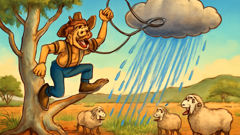
There was the time he took on the Great Speewah Drought, the kind that left frogs burrowing deep and cattle wandering for water. While others despaired, Mick hatched a plan. He climbed the highest gum tree on the station—some say it scraped the clouds—and lassoed a passing rainstorm. With a wink and a word, he wrangled that storm down over the Speewah, squeezing out every drop until the billabongs brimmed and the dust turned to emerald grass. The kangaroos came back to dance in the rain, and the galahs sang so loud the boss thought it was thunder. From that day, whenever dark clouds gathered, folks would look skyward and reckon Mick had business up above.
Then there was the epic flood—when the sky opened and rivers rose faster than a snake’s temper. The homestead floated off its stumps, sheep washed downstream, and even the tough old crows looked nervous. Mick didn’t fret. He tied a rope to the kitchen chimney, grabbed a fence post, and rowed through the floodwaters, rescuing dogs, chooks, and a family of possums who’d taken refuge in the water tank. By sundown, he’d herded every last sheep back to higher ground—except for one stubborn old ewe who’d floated all the way to the next station. Mick just shook his head and said, “She’ll be back for breakfast.”
No bush legend is complete without a run-in with outback critters. Crooked Mick’s were the wildest of all. When a plague of giant rabbits tunneled under the sheep yards, Mick chased them out by digging tunnels even deeper—and sent word to the wombats that the new digs were ready. When snakes curled up in the cook’s boots, Mick simply invited them to join smoko, and after a yarn or two, they slithered off in peace. He once taught an emu to tap-dance so well it won first prize at the Speewah Show.
But perhaps the tallest tale of all is the day Mick took on the legendary Speewah Bushfire—a monster that roared across the horizon, turning the sky black and the earth to glass. While everyone else fled, Mick strode straight into the flames. He dug a trench so deep it created its own river, then filled his hat with water from every billabong along the way. With hat in hand, he doused the flames and saved the whole station from disaster. To this day, old-timers claim you can see his footprints baked into the clay where the fire turned to steam.
These stories grew with every retelling—at bush dances, around campfires, in the lonely glow of an outback pub. Children begged for tales of Crooked Mick’s daring, while grown-ups smiled and nodded, knowing the heart of every yarn was true: that in the wildest land on earth, courage, wit, and a bit of mischief could turn even disaster into legend.
Conclusion
In the end, Crooked Mick’s story is more than just a collection of tall tales spun beneath outback stars. His legend stands as a testament to the spirit of Australia itself—a place where humor tempers hardship, resilience is forged in dust and flame, and even the wildest dreams are given room to run free. Whether he’s wrestling droughts or rainclouds, shearing sheep or wrangling rabbits, Mick reminds us that greatness isn’t always about size or strength—it’s about heart, wit, and the courage to face whatever comes across the wide red plains. Long after the last campfire has burned down and the gum trees have bent their ancient backs against another storm, Crooked Mick’s grin still lingers on the wind—a promise that in the wildest corners of the earth, legends can grow as large as we dare to imagine.










